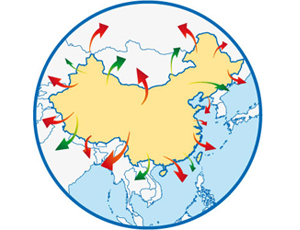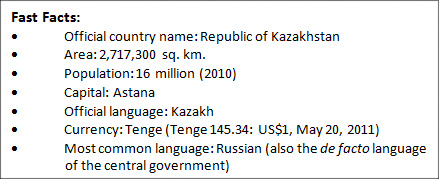The China Alternative – Kazakhstan
 The China Alternative is our series on other manufacturing destinations in Asia that are now starting to compete with China in terms of labor costs, infrastructure and operational capacity. In this issue we look at Kazakhstan.
The China Alternative is our series on other manufacturing destinations in Asia that are now starting to compete with China in terms of labor costs, infrastructure and operational capacity. In this issue we look at Kazakhstan.
By Jane Shi
May 20 – Kazakhstan lies to the west of China, bordering Xinjiang Province. In 1991, Kazakhstan became the last Soviet-occupied nation to declare independence and like many former Soviet strongholds still retains a very authoritative political and economic nature. Government incumbents often enjoy a predictable edge in decision-making and re-elections; take for example the recent snap presidential election in which Mursultan Nazarrbayev was re-elected to office for another term with 95 percent of votes, making it the beginning of his fourth term and eleventh year in office.
“Since Kazakhstan gained independence, no election has been judged free or fair by international observers, and the latest election was no exception,” writes country report analysts of the Economist Intelligence Unit. But even so, the political atmosphere in Kazakhstan is relatively stable and positive public opinion is high as the government maintains growth and improvement in the country’s social-economic conditions.

Economy Overview
In 2010, real GDP in the Kazakh economy grew by 7 percent year-on-year, backed by increased international demand, improved domestic consumption, and a 9.6 percent growth in industry. While real GDP growth is expected to drop in 2011 to 5.3 percent from slower external demand and lower rates of oil production, investments in projects that are critical to the mining and oil sectors will continue to be key drivers of the Kazakh economy.
According to the 2010-2014 National Program of Forced Industrial Innovative Development passed in February 2010, GDP growth by 2014 is set to be 50 percent of the rate in 2008, non-oil and gas exports are to increase by 40 percent, and energy intensity as a component of GDP is to decrease by 10 percent.
Kazakhstan’s agricultural sector, which accounted for 1.2 percent of GDP in 2010, suffered an 11.7 percent drop in growth due to severe droughts. While this is a small figure in relation to the country’s overall economic composition, the shrinkage in food production coupled with rising global commodity prices put greater inflationary pressures on domestic goods prices.
Annual inflation clocked in at an average 7.1 percent for 2010, right in agreement with the National Bank of Kazakhstan’s (NBK) aim to keep inflation between 6 percent and 8 percent. Restrictions on credit loans for corporations and consumers and large purchases of foreign currency by the central bank have aided the control of inflation, monetary stability, and competitiveness of non-oil sectors in the face of higher oil prices, external surplus, and a floating currency. In February, Kazakhstan’s currency the Tenge entered into a managed float exchange system under assumptions of slow appreciation as stated by the head of the NBK.
Tax revenues were by far the greatest contributor to a Tenge 20 billion (US$136 million) surplus in the 2010 state budget – 90.4 percent of total revenue was collected from taxes alone.
Industrial development
Like many former Soviet societies, the national economy and development are highly regulated by central government agencies in Kazakhstan. Since the Global Financial Crisis, the Kazakh government has focused keenly on building diversity in its industries that contribute to GDP and expanding its exports of gas and oil energy. Rich in minerals and other natural resources, Kazakhstan has become the largest economy in central Asia. In 2010, mineral products and hydrocarbons accounted for 74.9 percent of exports; the remaining 25.1 percent consisted of metals, chemicals, food products, and others.
China, Germany, and Russia are the top export and import trading partners of Kazakhstan.
Uranium
The country is first in the world for its accessible supply of uranium, but after the March earthquakes and the Fukushima Daiichi nuclear plant crisis in Japan, the short-term outlook for Kazakhstan’s uranium industry is stagnant at best. China’s large nuclear program has been put on hold, the United States is busying its programs with safety reviews, and Germany has temporarily suspended activities at seven of its plants. Dropped demand coupled with lower global prices have further encouraged the government to strengthen the economy’s non-energy sectors.
Oil
Oil, on the other hand, is likely to experience a comeback in support of the Kazakh economy as global crude prices rise steadily after the sudden drop in late 2008 and production volumes in Kazakhstan simultaneously increase. Major new oil field developments are in progress in the Caspian Sea and northwestern Kazakhstan, which will likely boost production supplies for both export and domestic use in the near future.
Kashagan oil field, developed by the state-run KazMunaiGas and a consortium of major MNC investors that include the likes of Royal Dutch Shell, Italy’s ENI, France’s Total, ExxonMobil, and Japan’s Inpex, is expected to begin production by late 2012 or early 2013.
Other major oil fields in the country include Arystan, Borankol, Karachaganak, Khvalynskoye, Kurmangazy, Tengiz, and Zhanazhol.
Most of the oil pumped from Kazakhstani fields is directed into pipelines bound for Russia. Looking forward, the government seeks to diversify its direct connections to neighboring countries and gain better leverage in price negotiations with Russia and similar parties as a result. Limited access to major seas and waterways has also weighed on the government’s ability to take more advantage of the country’s rich supply.
Diversifying the industries portfolio
As mentioned above, the Kazakh government is looking to lessen its economic dependence on oil by strengthening its non-oil industries. Targeted sectors for development include transportation, pharmaceuticals, telecommunications, petrochemicals, food processing, textiles, and tourism, among many others. The 2010-2014 National Program also stipulates development target goals such as:
- At least 12.5 percent increase in the manufacturing industry’s contribution to GDP
- At least 43 percent increase in non-primary export volume to total volume produced in manufacturing
- At least 50 percent increase in manufacturing labor productivity
- At least 100 percent increase in labor productivity in select sectors
- At least 10 percent increase in innovative enterprises
- At least 8 percent decrease in transportation costs
As central ministries and regional offices pass subsequent plans to address the goals outlined in the national plan, Kazakhstan will concentrate much of their developmental efforts on diversifying the strengths of their industries portfolio. For instance, the Ministry of Industry and Trade presented a directive in September 2010 for improvements of Kazakhstan’s construction and building materials industry. The initiative is significant for reducing the country’s dependence on imports. Goals of the program, to be reached by 2014, include gross value-added increases to GDP by 76 percent and domestic demand increases by 80 percent.
Foreign investment
Accordingly, the environment for foreign investors will also expand as the country looks to bring in more technology, expert knowledge, and funding. Several parts of the National Program point to this, including:
- Attracting foreign investments in technology SMEs aimed towards production of export-oriented products and substitutes to current imports
- Giving foreign investors equal access to the Program as domestic entities
- Increasing the number of foreign-expertise training programs in oil, chemical, high-technology, and engineering sectors to facilitate the domestic skilled-labor
- Improving production and standards in agricultural processing and light industries towards better access to foreign markets
- Increasing foreign-expertise training in the spacecraft manufacturing, launching, IT, and services sectors towards better access to foreign markets
- Creating a more favorable environment for foreign investors in priority sectors such as energy efficiency
- Developing joint educational/research projects between domestic and foreign universities, firms, and institutes with funding from national and international companies
- Acquiring knowledge of foreign standards and protocols for streamlining documents and paperwork frameworks to international specifications
- Increasing foreign workers in the labor force
- Implementing tax and other doing-business incentives for select foreign investors in projects deemed large and critical by the government
- Implementing administrative frameworks for the protection of foreign investors in Kazakhstan
- Eliminating barriers to foreign investments and trade
The World Bank Doing Business Index for 2011 gave Kazakhstan an outstanding jump in its ranking for the ease of starting a business in the country by 38 spots to #47, more than 100 spots above China. Positive changes are present in other indicators of the rankings with the exception of the ease of acquiring credit, which is likely a reflection of tighter regulations on credit grants as the central bank addresses inflationary pressures.
At a time when China is placing greater restrictions on foreign involvement in domestic industries, Kazakhstan’s expanding support of foreign investment and involvement in its economy may be just the right breath of fresh air for certain industry investors.
Dezan Shira & Associates‘ partner practice in Kazakhstan, the Almaty-based consulting firm Kazakhstan Consulting, can offer advice over matters of Kazakhstan foreign direct investment law, establishment, taxes and accounting issues. For further information please email info@dezshira.com.
Related Reading
Our complete series on other manufacturing destinations in Asia that are now starting to compete with China in terms of labor costs, infrastructure and operational capacity.
This unique book is an introductory study of all 14 of China’s neighbor countries: Afghanistan, Bhutan, India, Kazakhstan, Kyrgyzstan, Laos, Myanmar, Mongolia, Nepal, North Korea, Pakistan, Russia, Tajikistan and Vietnam.
 Operational Costs of Business in China’s Inland Cities
Operational Costs of Business in China’s Inland Cities
It is widely held that land and labor costs in inland provinces offer quite significant cost savings over major east coast and southern cities. In this issue, we take a quick look at the numbers behind these beliefs.
- Previous Article China Renewable Energy Industry Report: May 19
- Next Article China vs. Vietnam as the Future Workshop of the World

 The China Alternative
The China Alternative China’s Neighbors
China’s Neighbors







